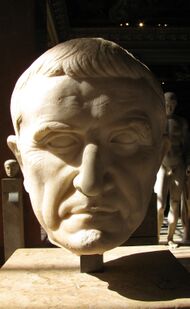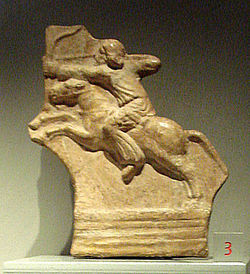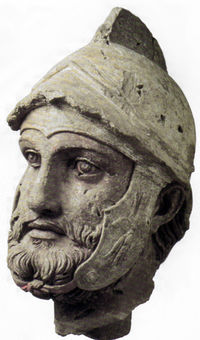What was the impact of the Battle of Carrhae (53BC) on Rome
Warfare defined the final century of the Roman Republic. Battle of Carrhae (53 BC) was one of the most important because it had profound implications for both Rome and for the eastern provinces of its Empire. At this battle, for the first real time, the Empires of Rome and Parthia clashed. Carrhae was one of the greatest and most decisive Roman defeats in its thousand year history.
This article will examine the impact of the defeat at Carrhae on Rome. The defeat resulted in the fall of Crassus, which hastened the start of the civil war between Caesar and Pompey. The outcome of which was the end of the Roman Republic and the introduction of an imperial system in Rome. Carrhae also meant that Roman expansion in the east was contained and that for several decades the Parthians were a grave threat in the Roman East. The Roman defeat left a legacy of enmity between Rome and Parthia that led to many more wars in the region.
Background
Roman had annexed Asia Minor and the truncated Seleucid Empire in the 1st century AD. This was to have far-reaching strategic repercussions for the Romans. For the first time, they came into contact with the Parthian Empire. The Parthians were an Iranian people who carved out an extensive Empire out of the Seleucid Empire. Their empire stretched from modern Iraq to Pakistan. Rome in the 1st century AD had greatly expanded its Empire and many of its leaders believed that the Republic was invincible.[1]
Rome by the 50s BCE was ruled by a ‘Triumvirate’ of Caesar, Pompey, and Crassus. This, known as the ‘First Triumvirate’ was an informal political alliance between the three most important men in Rome. Caesar who had been the leader of the popular party was in Gaul conquering that vast area. Pompey had won many victories in the East and was commonly referred to as Pompey the Great. Crassus' (115-53 BCE) power rested on his fabulous wealth and his ability as a political operator.
In this period success in battle was a requisite for political power. Crassus was very aware that he did not have any great military victories. He had played a leading role in the suppression of the Revolt of Spartacus, but this was not considered glorious enough for him. He needed a victory for his and his son’s career. Parthia was largely an unknown entity, but the Romans had heard that it had lately been weakened, because of a succession crisis. This and his political ambition persuaded Crassus to invade the Empire with the belief that he could conquer it. He had himself appointed the governor of Syria and made preparations to invade Parthia. This was contrary to the Senate's policy which had not sought conflict with the Parthian monarchs.
The Battle
Crassus landed in Asia Minor with a large army, some estimate it to be 50,000 strong. The Roman commander had little military experience, but his son was a seasoned and respected campaigner. The Romans knew little about the lands that they were going to invade.[2] The king of Armenia offered to allow the invading army to enter Parthia via his kingdom. This would have allowed the Roman legions to march down into modern Iraq and on to the capital of Parthia, Ctesiphon. Instead, Crassus invaded by way of Turkey. This was an area largely of plains and it was ideal for cavalry. Several Roman commanders including Cassius tried to dissuade him from this course.
However, Crassus was overconfident and believed that his army was invincible. The Romans outnumbered the Parthians and their allies by up to four to one. The Parthians were mainly cavalry and they had little infantry. They were led by a general of genius Surena, who came from Central Asia. Suren adopted guerrilla tactics at first and used his superior cavalry to harass and inflict casualties on the Romans.[3]. Surena decided to confront the advancing Crassus at the small town of Carrhae in modern Turkey. The Parthians used their cavalry archers to launch hit and runs attacks on the Romans who were in tight formations. Crassus hoped that the Parthians would run out of arrows, but Suren used Bactrian camels to re-supply his forces with arrows. Under the relentless showers of arrows, the Roman legionnaires could not move, and their supplies ran low.[4]
According to Plutarch "Now if they had hopes that the enemy would exhaust their missiles and desist from battle or fight at close quarters, the Romans held out; but when they perceived that many camels laden with arrows were at hand, from which the Parthians who first encircled them took a fresh supply.’[5] The Roman commander repeatedly ordered that his army move forward and engage with the enemy. However, each time the legions advanced the Parthian cavalry retreated and firing arrows as they did. This caused many casualties among the Romans and their morale began to collapse.[6] It is claimed that many of the Parthian arrows could pierce armor and pinned Romans to the ground. After several days, the army of Crassus was on the verge of mutiny. They forced Crassus to negotiate with Suren. At these negotiations a tenative agreement was reached which could have have allowed the Romans to withdraw safely from Parthian territory in return for the evacuation of several Roman garrisons from east of the Euphrates (in modern Iraq).
However, during the meeting between the Roman and the Parthian commanders one of the soldiers of Suren seized the reins of Crassus horse and this lead to a skirmish.[7] In this Crassus and his son were killed, leaving the Romans leaderless and they were effectively cut off in enemy territory.[8] Surena then ordered his heavy cavalry the cataphracts (the forerunners of the medieval knight) to charge into the Roman lines. They were ineffective, but they caused panic among the legionnaires. The Romans began a disorganized retreat and they came under constant attack from the forces of Suren. Many Romans made it back safely to Syria, but it is estimated that some 20,000 legionnaires were killed and another 10,000 captured during the chaotic retreat. Those captured were paraded through the Parthian Capital and later made to work as slaves in Central Asia.[9]

Immediate aftermath
The victors at Carrhae attempted to seize Roman territory in Syria but they were beaten back by the remaining Roman forces under Cassius, who was later one of the ringleaders in the assassination of Julius Caesar regrouped in Syria. Suren despite his victory was later executed by the Parthian monarch Odores II who feared his power and popularity. This may have been a blessing for the Romans as, without the leadership and strategic vision of Surena, they failed to secure their objectives. Cassius proved to be a very capable general. The Parthian Crown Prince invaded Syria but was ambushed by Cassius, defeated and killed.
However, the Parthians were able to conquer the strategic kingdom of Armenia in the Caucuses. From here they were able to threaten the Roman possessions in Asia Minor, a situation that was to last for many decades. Carrhae left the Roman East exposed and it was to be invaded several times in the next decades by Parthia. Syria was occupied twice by the Parthians and on one occasion they installed a puppet king in Judea. For several decades until the reign of Augustus, the Roman East was left exposed to regular Parthian incursions and interference, by the defeat of Crassus in 53 BC.
Roman and Parthian Wars
Prior to Carrhae, Rome had expanded rapidly and almost at will. However, the defeat at Carrhae and ended this seemingly remorseless expansion in the Middle East. In the aftermath of the defeat, Rome withdrew some garrisons from the eastern side of the Euphrates River. However, the defeat was a national humiliation and especially the legionary eagles that were seized by the Parthians at Carrhae. Caesar swore revenge, and many believe that he was going to invade Parthia before his assassination. The defeat at Carrhae, was something that the Romans had to be avenged. During the civil wars the Parthians supported the enemies of Caesar. During the Roman civil wars in the 40s BCE the Parthians were able to occupy much of the Roman East.[10]
The end of the second Roman Civil War allowed the Romans to retake their possessions. Mark Anthony later launched an invasion of Parthia to punish the victors of Carrhae, but this too ended in a disaster. The lessons from the defeat were not learned. It was up to Augustus to develop a strategy that led to a period of peace. He was later able to negotiate to have the legionary standards that were captured at the defeat to be returned to Rome. However, the defeat continued to haunt Rome and many emperors dreamt of avenging that most calamitous defeat. There were persistent tensions between Rome and Parthia. The two countries were strategic rivals after the battle and each vied for influence in the strategically important kingdom of Armenia.[11] The relative calm of the 1st century was ended by the invasion of Trajan of Parthia and the next few decades saw many wars between the two great powers in the Ancient Near. Carrhae was the beginning of some two centuries of mistrust and occasionally war between Rome and Parthia.
Carrhae and the end of the Roman Republic
The disaster at Carrhae was soon followed by a series of civil wars that were only ended by the fall of the Republic. The Republic had been greatly weakened by the March of Sulla on the city and his seizure of power. However, the death of Crassus at Carrhae was a crucial stage in the fall of the Roman Republic. Many historians have linked the death of Crassus at Carrhae with the beginning of the civil wars. Crassus had ensured that Pompey and Caesar continued to cooperate in the First Triumvirate. The death of Crassus and the death of Julia the wife of Pompey and the daughter of Caesar ended the ties that bound Pompey and Caesar.
Without Crassus in the First Triumvirate, it was inevitable that the political alliance would collapse. If Crassus had lived then he could have maintained the balance of power between Pompey and Caesar, which could have prolonged the life of the Republic. Another theory is that Crassus was essential to the relationship between Caesar and the Roman Senators. Without him, the relationship between the conqueror of Gaul and the Senate deteriorated in the wake of Carrhae.[12] After the death of Crassus, the relationship between Caesar and the Senate broke down, irretrievably, over command of the legions on Gaul. Civil War broke out when Caesar crossed the Rubicon. The disaster at Carrhae helped to create a set of circumstances that led to a period of civil wars that ended with an imperial form of government in Rome.
Conclusion
Carrhae was a humiliation for Rome. It also had profound implications for the Republic and later its successor the Empire. The near annihilation of the invasion force of Crassus had profound implications. It meant that the Roman Near East was left very exposed for several decades and it suffered frequent Parthian incursions and interference. It was only with the establishment of the Imperial system that Rome’s eastern provinces could be properly protected. The disaster at Carrhae meant that Rome came to fear and hate Parthia and many, such as Mark Anthony, wanted to avenge the defeat. This all contributed to a series of wars between Parthia and Rome. The death of Crassus helped to destabilize the politics in Rome. He was able to maintain a balance of power between Pompey and Caesar. With his death, it was perhaps inevitable that the two men would fight for supremacy in Rome. The conflict between the Caesar and Pompey led to a series of civil wars, that ultimately resulted in the collapse of the Roman Republic.
Related DailyHistory.org Articles
- How did the Etruscans shape Roman history and society?
- What was the impact of the Battle of Teutoburg Forest on the Roman Empire?
- What Role Did Inflation Play in the Collapse of the Roman Empire
- What was the impact of Attila the Hun on the Roman Empire?
- What was the impact of Augustus' victory over Mark Anthony and Cleopatra on Rome?
References
- ↑ Sampson, Gareth, The Defeat of Rome: Crassus, Carrhae, and the Invasion of the East (Barnsley: Pen & Sword Military, 2008), p. 17
- ↑ Sicker, Martin"Carrhae," in The Pre-Islamic Middle East (Greenwood Publishing Group, 2000), pp. 149–51
- ↑ Sicker, p.150
- ↑ Sampson, p. 117
- ↑ , Plutarch, Life of Crassus, xxi
- ↑ Sicker, p. 149
- ↑ Plutarch, xxiii
- ↑ Sampson, p. 119
- ↑ Sicker, p. 151
- ↑ Holland, Tom. Rubicon : the last years of the Roman Republic (London, Doubleday, 2005), p 45
- ↑ Holland, p. 203
- ↑ Holland, p. 245


